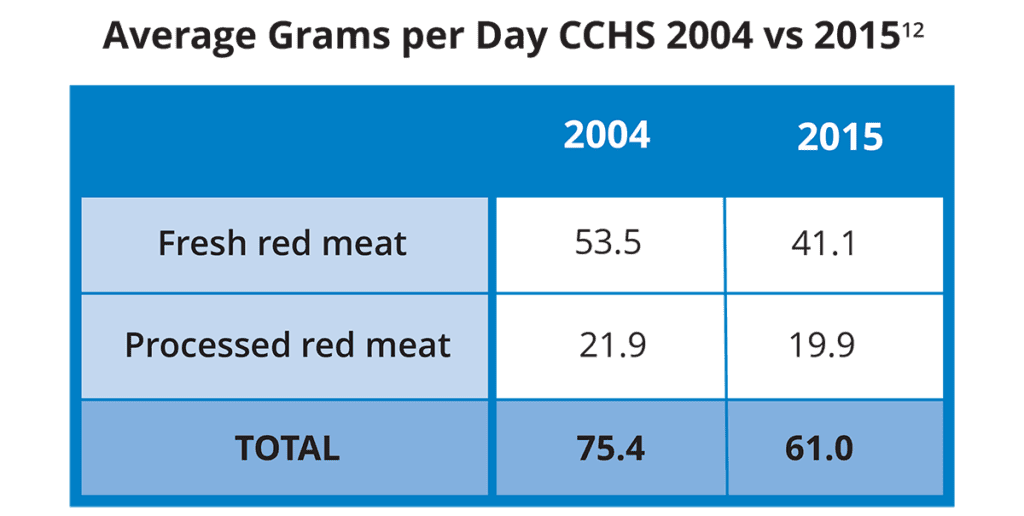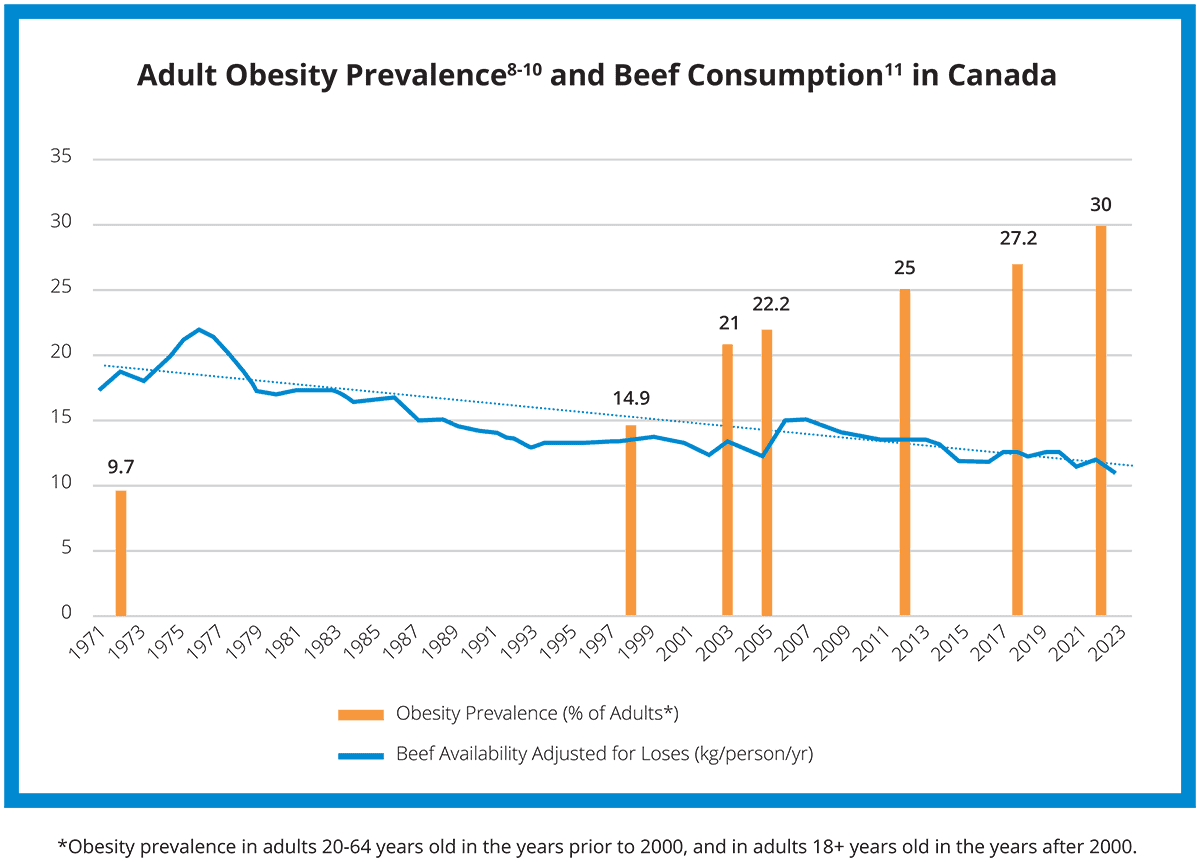Key points:
- Diabetes has increased in Canada along with obesity (a major risk factor for diabetes), while red meat consumption has declined.
- Diabetes is a disease of blood sugar dysregulation, and unprocessed meat is naturally free of carbohydrates and sugar.
- Several recent rigorous reviews of the evidence on red meat and diabetes suggest there’s no reason to replace red meat.
 Diabetes is on the rise in Canada
Diabetes is on the rise in Canada
Diabetes is a serious chronic disease characterized by high blood glucose (sugar) that affects many Canadians. In 2023, 1 in 10 people in Canada were living with diagnosed diabetes and rates are expected to climb according to Diabetes Canada.1

The percent of the population affected also increases markedly as people age. By 2020-2021, more than 1 in 4 seniors (27%) aged 65 years and over were living with diagnosed diabetes.3
Undiagnosed diabetes and prediabetes affect even more Canadians. Diabetes Canada estimated that when both diagnosed and undiagnosed cases are accounted for, 30% of people in Canada were living with diabetes or prediabetes in 2023.1 This includes type 1 and type 2 diabetes. By 2033, it is projected that 33% will be living with diabetes or prediabetes (diagnosed or undiagnosed).1 Prediabetes increases the risk of developing diabetes.
Among adults in Canada, it has been estimated that about 90% of diabetes cases are type 2, 9% are type 1, and less than 1% are another type.2 In children and youth, most cases are type 1 diabetes, but type 2 diabetes is on the rise. In fact, a nation-wide study published in 2023 found a 60% rise in the incidence of type 2 diabetes in children under 18 years over a decade.4,5
Being overweight is a major risk factor for type 2 diabetes
According to Diabetes Canada, “An estimated 80% to 90% of people with type 2 diabetes have overweight or obesity.”6 The 2021 Global Burden of Disease Study reported high Body Mass Index (i.e. overweight or obesity) to be the primary risk factor for type 2 diabetes.7 In Canada, the prevalence of diabetes has increased1,2 as the prevalence of obesity has increased8-10 over the years.
While diabetes and obesity have increased, red meat intake has declined
It’s worth noting that while the prevalence of diabetes has been steadily increasing in Canada, red meat intakes have not. In fact, while the prevalence of diabetes nearly doubled between 2003 and 2023,1,2 and the prevalence of obesity tripled in adults since the early 1970s,8-10 food availability data from Statistics Canada indicate Canadians now eat considerably less beef than they did in the 1970s.11
Although dated, the available Canadian Community Health Survey (CCHS) data also show a downward trend in red meat consumption between the 2004 and 2015 surveys.12 The latest national CCHS 2015 survey data show that Canadians generally eat a moderate amount of red meat such as beef, pork, and lamb.
 Understanding the role of diet in diabetes
Understanding the role of diet in diabetes
Diet plays an important role in regulating blood sugar and in preventing and managing diabetes. Paying close attention to the amounts and kinds of carbohydrates (including sugars) consumed is a key dietary strategy to help manage diabetes. This is fundamental since carbohydrates (broken down into sugars when digested) are absorbed into the bloodstream. Blood sugars that are not well managed increase the risk of developing a range of other health complications such as high blood pressure, heart disease, and damage to the nerves, eyes, and kidneys.
It’s good to know that unprocessed meat is naturally free of carbohydrates and primarily made up of protein along with some fat.
Canadians generally eat too many highly processed foods
While eating a healthy diet can reduce the risk of diabetes and complications such as heart disease and stroke, Canadians generally do not eat a very healthy diet. In fact, Canadians are the second largest buyers of ultra-processed foods and drinks in the world, accounting for 47% of calories consumed on average.13
Heart and Stroke Foundation research shows that Canadian adults who eat the highest amounts of ultra-processed foods have 37% higher odds of developing diabetes, 31% higher odds of obesity, and 60% higher odds of high blood pressure.13
Research indicates red meat can fit into diabetes-friendly diets
You may have heard mixed messages relating to red meat and diabetes, some positive and some negative. It’s important to know studies that have reported associations between red meat consumption and increased diabetes risk have generally been observational in nature.
Observational studies that explore associations between specific foods or dietary patterns and health conditions regularly generate conflicting findings. Observational studies try to find associations between dietary intakes and health measures. These often lead to media headlines causing confusion about food. However, nutrition scientists know that associations do not prove causation.
Several recent rigorous reviews of the available evidence suggest there’s no reason to replace red meat.14-18 A growing body of research indicates that eating a moderate amount of red meat within the context of a balanced diet has no adverse effect on blood sugar control or other diabetes or heart health risk markers.15,16,19 This evidence supports that when people eat a balanced diet, substitution of red meat with plant sources of protein would not further improve diabetes or heart health risk factors.16,19
Here are some important studies that have examined the place of red meat in relation to diabetes risk, finding that unprocessed red meat fits within a diabetes-friendly diet:
- Using a genetic analysis method called Mendelian randomization (a newer approach to assess causality), researchers recently found no evidence of a causal link between red meat (beef, pork, and lamb) consumption and the development of type 2 diabetes or cardiovascular disease (heart disease, high blood pressure, and stroke).14
- Two recent meta-analyses (statistical analyses of results from many studies on a topic) looked at dietary trials exploring red meat consumption and markers of diabetes in adults.15,16 Meta-analyses like these that examine the findings from randomized controlled trials (RCTs) are the gold standard in terms of evidence. RCTs are controlled experiments that can help us understand if dietary intakes are impacting health. It’s important to note that both of the following meta-analyses looked at RCTs that included mainly unprocessed red meat.
-
- A recent meta-analysis of 21 RCTs looked at the effects of red meat on blood markers of diabetes in adults.15 Researchers concluded that red meat had no adverse effect on a wide range of blood makers for type 2 diabetes, such as fasting blood glucose, HbA1c, fasting insulin and insulin sensitivity, as compared to diets with less or no red meat.
- Another meta-analysis of 20 RCTs explored the effects of diets with red meat on markers of blood glucose control and inflammation in adults at risk of diabetes, heart disease and stroke.16 This meta-analysis concluded that red meat had no adverse effect on blood sugar control or inflammation. Based on their analyses researchers also found there was no benefit of replacing red meat with other animal- or plant-based proteins such as poultry or soy.
- A recent Burden of Proof study evaluated all of the evidence from observational studies of unprocessed red meat and 6 common health conditions.17 Using rigorous burden of proof methodology, this meta-analysis concluded there is weak to no evidence of association between unprocessed red meat and type 2 diabetes, heart disease, colorectal cancer, breast cancer, or the two main types of stroke.
- Another expert panel concluded there is little to no health benefits for reducing red meat based on a series of 5 high-quality reviews on red meat and chronic diseases such as diabetes, heart disease and cancer.18 They estimated that adults in North America and Europe eat red meat and processed meat about 3 to 4 times a week on average. Based on their findings, they recommended that most people can continue to eat red meat at current average intakes.
- Researchers have compared the effects of eating red meat, soybean, and other legumes on heart health risk factors in adults with type 2 diabetes.19 Participants in this RCT ate a balanced diet designed to maintain their weight. They were assigned to 3 different groups: (1) red meat, (2) soybean, (3) non-soy legumes. Researchers concluded that compared to soybean or non-soy legumes, eating a moderate amount of unprocessed red meat (i.e., 337 g/week) had no adverse effect on a range of heart health risk factors including fasting blood sugar, fasting insulin, HbA1C, insulin sensitivity, cholesterol levels, and blood pressure in adults with type 2 diabetes.
- The effects of beef and protein were investigated in a recent weight loss study in adults with type 2 diabetes.20 This RCT showed that calorie-restricted diets with moderate or high amounts of protein (21% or 40% of total energy) combined with regular exercise are an effective way to help adults with type 2 diabetes lose weight and improve body composition, blood glucose control, and cardiometabolic health. Researchers found that the higher protein diet, which included beef at least 4 times a week, was as effective as the moderate protein diet with no red meat.
- A 6-month RCT demonstrated that a higher protein diet effectively reversed prediabetes in obese men and women.21 This dietary feeding study assigned adults with prediabetes to either a high protein (30% protein, 30% fat, 40% carb) or high carbohydrate diet (15% protein, 30% fat, 55% carb). After 6 months, 100% of those eating the high protein diet experienced remission of prediabetes to normal glucose tolerance, compared to only 33% of those on the high carbohydrate diet.
-
- Those eating the high protein diet also benefited from significant improvements in insulin sensitivity, lean body mass, cardiovascular risk factors, and inflammatory markers.21
- The high protein diet increased the hormones GLP-1 and GIP, which may be responsible in part for improved insulin sensitivity and β cell function compared to the high carbohydrate diet.22
- The results for the hunger hormone ghrelin demonstrated the high protein diet can reduce hunger more effectively than the high carbohydrate diet.22
The bottom line
All of these facts and findings suggest that eating a moderate amount of unprocessed red meat does not increase the risk of diabetes. Since Canadians are already eating a moderate amount of unprocessed red meat on average, this research does not support a need to decrease intakes.
Beef is an excellent source of protein that provides a wide range of essential vitamins and minerals.23 It’s a good choice to fill the protein portion of your plate.
For more evidence examining beef and chronic disease, read our Research Update.
To learn more about healthy eating from Diabetes Canada, read Just the Basics.
September 2024
References
- Diabetes Canada. 2023. Diabetes in Canada – 2023 Backgrounder.
- Public Health Agency of Canada. 2017. Diabetes in Canada.
- Public Health Agency of Canada. 2023. Snapshot of diabetes in Canada, 2023.
- Patel TJ et al. Incidence trends of type 2 diabetes mellitus, medication-induced diabetes, and monogenic diabetes in Canadian children, then (2006–2008) and now (2017–2019). Pediatric Diabetes, 2023;5511049.
- University of British Columbia Faculty of Medicine, Department of Pediatrics. 2023. Communication update: 60% increase in type 2 diabetes (T2D) among Canadian children.
- Diabetes Canada. 2024. Weight Management.
- Global Burden of Disease 2021 Diabetes Collaborators. Global, regional, and national burden of diabetes from 1990 to 2021, with projections of prevalence to 2050: a systematic analysis for the Global Burden of Disease Study 2021. Lancet 2023;402:203-234.
- Katzmarzyk PT. The Canadian Obesity Epidemic: An Historical Perspective. Obes Res 2002;10:666 –674.
- Statistics Canada. 2024. An overview of weight and height measurements on World Obesity Day.
- Lytvyak E et al. Trends in obesity across Canada from 2005 to 2018: a consecutive cross-sectional population-based study. CMAJ Open 2022;10(2):E439-E449.
- Statistics Canada. Table 32-10-0054-01 Food available in Canada. Beef, boneless weight adjusted for losses from 1971 to 1923.
- Statistics Canada analysis of 2015 and 2004 Canadian Community Health Survey – Nutrition data.
- Heart and Stroke Foundation of Canada. 2019. News release: Simpler is better when it comes to healthy eating.
- Li G, Jiang J and Li Z.The relationship between processed meat, red meat, and risk of cardiovascular disease and type 2 diabetes: A Mendelian randomization study. Eur J Prev Cardiol 2024: Online ahead of print. Doi: 10.1093/eurjpc/zwae117.
- Sanders LM, Wilcox ML and Maki KC. Red meat consumption and risk factors for type 2 diabetes: a systematic review and meta-analysis of randomized controlled trials. Eur J Clin Nutr 2023;77(2):156-165.
- O’Connor LE et al. Effects of total red meat intake on glycemic control and inflammatory biomarkers: a meta-analysis of randomized controlled trials. Adv Nutr 2021;12:115-127.
- Lescinsky H et al. Health effects associated with consumption of unprocessed red meat: A Burden of Proof study. Nat Med 2022;28:2075–2082.
- Johnston BC et al. Unprocessed red meat and processed meat consumption: dietary guideline recommendations from the Nutritional Recommendations (NutriRECS) Consortium. Ann Intern Med 2019; 171:756-764.
- Hassanzadeh-Rostamiz Z et al.Moderate consumption of red meat, compared to soy or non-soy legume, has no adverse effect on cardio-metabolic factors in patients with type 2 diabetes. Exp Clin Endocrinol Diabetes 2021;129(6):429-437.
- Clina JG et al. High- and normal-protein diets improve body composition and glucose control in adults with type 2 diabetes: a randomized trial. Obesity 2023; 31(8):2021-2030.
- Stentz FB et al. Remission of pre-diabetes to normal glucose tolerance in obese adults with high protein versus high carbohydrate diet: randomized control trial. BMJ Open Diabetes Res Care 2016;4(1):e000258.
- Stentz FB et al. High protein diet leads to prediabetes remission and positive changes in incretins and cardiovascular risk factors. Nutr Metab Cardiovascular Dis 2021;31(4):1227-1237.
- Health Canada. 2015. Canadian Nutrient File. Nutrient values per 100 g for Food Code Beef 6172 (composite cuts, steak/roast, lean and fat, cooked).






